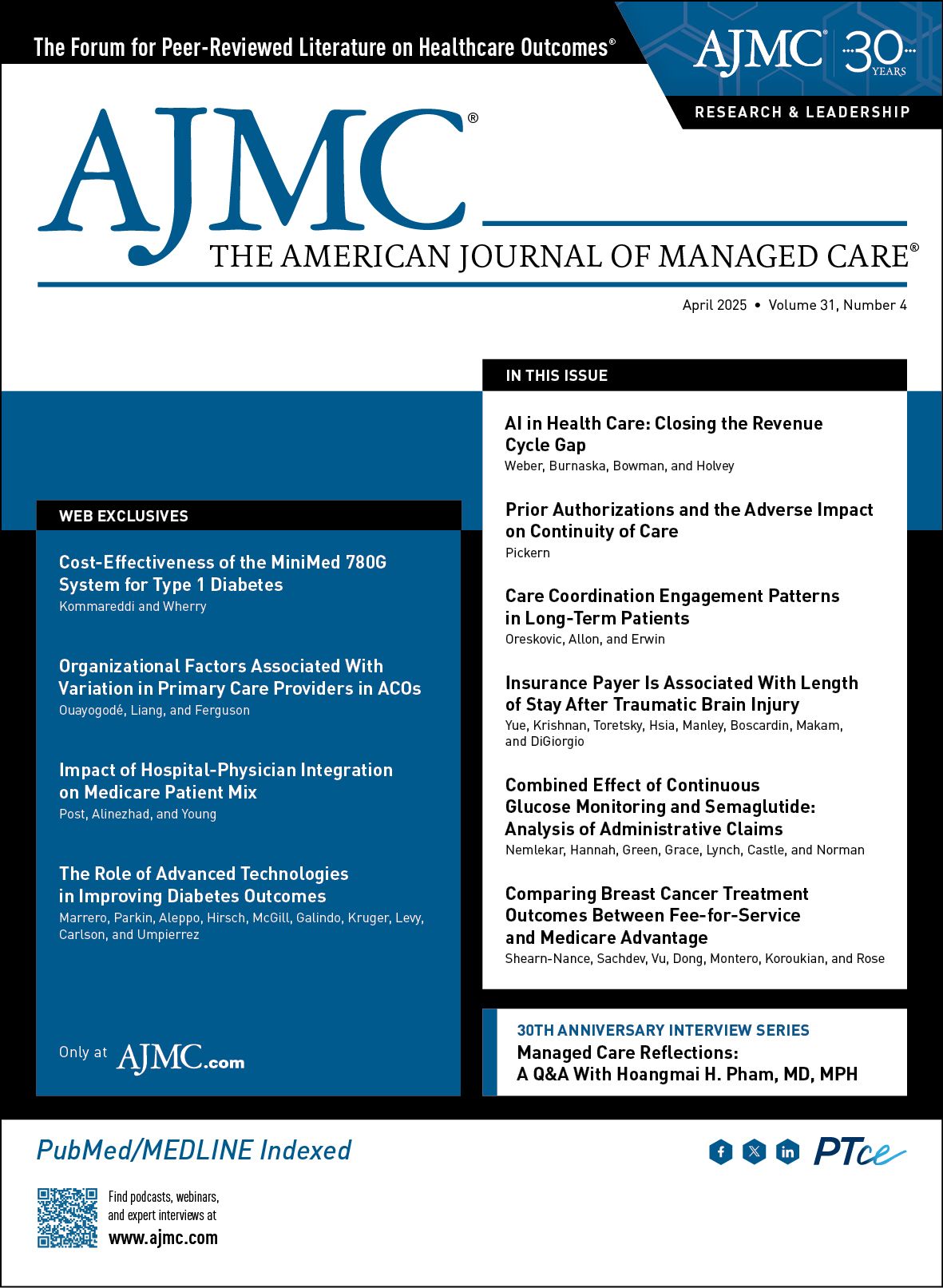Publication
Article
The American Journal of Managed Care
Care Coordination Engagement Patterns in Long-Term Patients
Author(s):
Care coordination engagement increases over time in long-term high-cost, high-need patients, with no identifiable data-driven times for when to initiate patient care de-escalation.
ABSTRACT
Objective: Health care networks are increasingly turning to programs that provide office-based care coordination to high-cost, high-need patients to control preventable health care costs. Although care coordination programs have been shown to result in shorter-term cost benefits, little is known about patients who remain in such programs beyond 2 years. This study sought to assess the amount of care coordination engagement over time in patients enrolled for more than 2 years in an office-based care coordination program.
Study Design: Cohort study with 9 years of follow-up data.
Methods: The study population was adult patients enrolled for 2 or more years as of November 2023 in an office-based care coordination program at a major academic medical center in Boston, Massachusetts. The association between patient length of enrollment in an outpatient care coordination program and amount of care coordination engagement was assessed using linear regression, with differences between cohorts compared by t test and analysis of variance. Engagement patterns in 5 sequential study cohorts based on date of enrollment were compared.
Results: Among all 2258 patients enrolled, care coordination engagement increased linearly over time, with a mean increase of 0.2 care coordination encounters per patient per year. Similar increasing engagement patterns over time were observed across all study cohorts.
Conclusions: Length of time enrolled in an office-based care coordination program predicted care coordination engagement, with care coordination services increasing the longer patients remained in the program.
Am J Manag Care. 2025;31(4):166-171. https://doi.org/10.37765/ajmc.2025.89718
Takeaway Points
We aimed to assess the long-term program utilization of high-cost, high-need patients enrolled in office-based care coordination programs.
- In this 9-year cohort study of 2258 high-cost, high-need patients enrolled in an office-based care coordination program in Massachusetts, program engagement increased linearly over time.
- Overall engagement patterns did not vary by date of enrollment, enrollment prior to or after the COVID-19 pandemic, the amount of individual program engagement, and whether care coordination was provided by a nurse or social worker.
- Care coordination engagement increases over time in high-cost, high-need patients, with no identifiable data-driven times for when to initiate patient care de-escalation.
The continual increase in medical spending over the past several decades along with the growth in shared financial risk models has incentivized health care systems to search for innovative ways to limit health care spending.1-3 One area of focus for limiting health care costs has been on high-cost, high-need (HCHN) patients. Although HCHN patients represent fewer than 5% of the population, these complex patients can account for more than half of health care spending.4 With a large share of costs among HCHN patients classified as preventable, an increasing number of health care systems across the US are turning to outpatient care coordination programs to improve care and decrease preventable care utilization among HCHN patients.5-7
Care coordination programs that combine chronic disease management and case management have been shown to improve care outcomes and reduce costs for HCHN patients.8-10 The Massachusetts General Hospital (MGH) integrated Care Management Program (iCMP) was established in 2006 as an office-based care coordination program with the primary aim of decreasing health care utilization in HCHN patients.11 The guiding objective of the iCMP is to help patients stay healthier longer by providing specialized care coordination services to prevent complications from their medical conditions and avoid unnecessary health care utilization, including emergency department visits and hospitalizations. The program works with the patient and their primary care physician to identify barriers to care and assist patients with coordination between services and providers by addressing barriers and providingservices including transportation, health literacy, medication management, appointment coordination and reminders, and procurement of durable medical equipment. The program relies predominantly on drop-in in-person office visits along with ad hoc telephonic visits and, increasingly since the COVID-19 pandemic, scheduled video visits between the patient and the care coordinator, all aimed at encouraging ongoing 2-way communication between the patient and their care coordinator.
The program began as a nurse-centric Medicare demonstration project with specific criteria on programmatic eligibility, enrollment, and outpatient care coordination provision processes. Today, the program has expanded to include nurses, social workers, and other allied health professionals embedded within primary care practices providing longitudinal outpatient care coordination to more than 4500 Medicare, Medicaid, and commercially insured HCHN patients receiving primary care at MGH. Most eligible patients are identified for the program by a machine learning algorithm that uses claims data and the Johns Hopkins ACG System32 grouper to identify patients with multiple chronic conditions and high utilization of health care services with a predicted risk of becoming high-cost high utilizers in the future; primary care physicians may also request for patients to be enrolled in the program. The most common medical comorbidities in enrolled patients include cardiovascular, gastrointestinal, neurological, hematologic and oncologic, and mental health conditions, with congestive heart failure and chronic obstructive pulmonary disease being two of the most common conditions.
Although iCMP has always had clear processes for eligibility, enrollment, and longitudinal services provision, there are no specific programmatic guidelines on when a patient should be graduated or discharged from the program. The lack of existing criteria clearly defining when to cease enrollment in iCMP has resulted in patients remaining in the program for several, and in some cases many, years. The original demonstration project showing programmatic benefits assessed patient enrollment over a 2-year period.12 It is unclear whether patients derive additional benefits from ongoing participation in the program beyond 2 years or what programmatic engagement looks like in these patients enrolled for longer periods of time. The main aims of this study were, therefore, to assess long-term care coordination patterns in patients enrolled in the MGH iCMP for greater than 2 years and whether patterns of outpatient care coordination engagement are associated with length of time in a care coordination program. The hospital’s institutional review board approved this study.
METHODS
Study Population
Patients followed at MGH and participating in the hospital’s accountable care organization (ACO) insurance coverage plans who had been enrolled in the iCMP for 2 or more years and remained enrolled in the program as of November 2023 were included in the study. We created cohorts based on calendar year at enrollment in the program, with cohorts grouped for every 2 years of enrollment; cohort 1 included patients enrolled prior to 2013, cohort 2 included those enrolled between 2014 and 2015, cohort 3 between 2016 and 2017, cohort 4 between 2018 and 2019, and cohort 5 between 2020 and 2021. Only patients continuously enrolled in the program from time of initial enrollment through 2023 were included the study. Per program policy, all enrolled patients are required to have an outpatient care coordinator and must have contact with their care coordinator at least once every 6 months. Although the program includes nurse, social worker, and community health worker care coordinators, only patients with a nurse care coordinator were included in the study’s primary analyses, as these patients represent the largest and most long-standing cohort of patients enrolled in iCMP. Data prior to 2016 were unavailable from the current electronic health record system. Patients primarily followed by a nurse care coordinator who were comanaged by a social worker or community health worker were included in the study.
Data Management
Data were cleaned to remove erroneous and administrative encounter data. Encounter data from the first month of enrollment in the program were removed to limit outlier effects because this first month represents a unique period with atypical care service patterns and outreach attempts aimed at enrolling a patient and establishing a care plan.
Statistical Analyses
To test the association between length of enrollment in an outpatient care coordination program and amount of care coordination engagement among HCHN patients, we ran models using linear regression. Care coordination engagement was defined as the number of documented care coordinator encounters with a patient per month within each cohort. As the number of patients within a cohort grew over time with enrollment, we used mean monthly values to account for different-sized cohorts over time. We used t tests, Welch tests, and analysis of variance to test for differences in slopes to assess differences in care coordination engagement between cohorts over time. Slopes represent a change in the number of encounters per patient within a calendar month over time.
We ran several additional analyses to assess for potential cohort bias. To assess whether patients with nurse care coordinators represent a distinct group of patients enrolled in the program, we analyzed engagement patterns over time in the study cohort that consisted of patients followed by a nurse care coordinator compared with a separate cohort of patients enrolled in the program and followed by a social worker care coordinator. Patients followed by a social worker care coordinator often have psychosocial and social determinants of health as drivers of their health care utilization and thus may have distinct care coordination engagement from patients followed by nurses, who often have more medical-related health care drivers. To assess for differences in type of care coordination service provided, we ran a subanalysis by encounter type for all 2022 data with each cohort that included 84 clinical encounter types binned into 8 encounter categories. We ran a subanalysis that included only patients who received a care coordination service every month to assess for differences among high-use patients. Finally, we ran a subanalysis comparing data before and after March 2020 to assess for possible COVID-19 pandemic–related effects.
RESULTS
The study included 2258 patients, with 319 patients in cohort 1, 303 in cohort 2, 378 in cohort 3, 565 in cohort 4, and 693 in cohort 5 (Table). Mean age at time of enrollment was 68.4 years and was similar across cohorts. The majority (60.8%) of patients were female; 74.1% were White, 9.3% were Black, and 7.6% were Hispanic. Most patients were English speaking (84.6%), 38.0% were married or living with a partner, and 77.5% had Medicare coverage.
The mean slope for the entire study group was 0.00013, equating to an increase of 0.2 encounters per patient per year (Figure 1). We found that care coordination encounters increased linearly over time, with similar slopes in all cohorts (P = .99), regardless of length of time enrolled in the program (Figure 2 and Figure 3).
In our secondary analyses, we found care coordination engagement patterns similar to those seen in the overall study cohort. We found no distinction in care coordination encounters over time between patients followed primarily by a nurse (n = 2258) vs a social worker (n = 443) care coordinator (mean slopes, 0.0001 vs 0.0002, respectively; P = .98). No differences in encounters over time were seen when data were analyzed by encounter category (data not shown). When analyzing the data among the subset of patients within each cohort receiving 1 or more care coordination services each month, there were no differences in encounters over time between cohorts, with similar increases over time across all cohorts (data not shown). There was likewise no difference in care coordination encounters over time for data before and after the onset of the pandemic (mean slopes, 0.0003 vs 0.0001, respectively; P = .86).
DISCUSSION
In this study looking at care coordination engagement in patients enrolled for more than 2 years in an office-based care coordination program, we found that engagement increased over time. The longer patients remained enrolled in the outpatient care coordination program, the greater the amount of outpatient care coordination services they received. To our knowledge, this is the first study to assess long-term patient engagement and service provision patterns in an outpatient care coordination program.
Our findings of the positive association between length of time enrolled in a care coordination program and amount of care coordination engagement were remarkably consistent across all patients enrolled in the program for more than 2 years, regardless of when they joined the program. These findings demonstrated a remarkably consistent and universal program, in which the linear increase in the number of care coordination services an enrolled patient receives is predictable and consistent and can be calculated simply based on time since initial programmatic enrollment. We found no natural inflection point where engagement flatlines or decreases over time, no difference based on how long a patient has been enrolled in the program, no difference among patients whose care coordinators were nurses or social workers, no difference based on the clinical reason for the encounters, no difference based on amount of services received within a given cohort, and no difference in engagement before or after the COVID-19 pandemic.
There are several possible explanations for our findings of a linear increase in outpatient care coordination engagement with length of time enrolled in the program. One possible explanation is that the services provided in the outpatient care coordination program were driven by internal rather than external forces. In an internally driven program, the program runs on internal programmatic dynamics where the program determines what services are provided to the patient rather than being shaped by external factors where patient circumstances and needs drive care coordination service provision. Another possible explanation may be the aging process. As patients age, they develop increased medical complexity and comorbidities and incur a greater need for health care services, which a program such as iCMP is equipped and able to provide.
Regardless of the underlying explanation, the findings have important programmatic implications. The data suggest that there is no natural inflection point or flattening of the health care utilization curve over time. There appears to be no point in time evident from the data when patients naturally stabilize. Nor did we isolate an easily identifiable point in time during a patient’s enrollment in a care coordination program based on health care services data when graduating a patient from a care coordination program would be justifiable. We cannot therefore rely on patient engagement data to identify the optimal time to graduate patients from the care coordination program. The implication of our findings is that there is no logical time to discharge patients or step down the level of care provision. Our findings suggest that outpatient care coordination programs need to develop new approaches for identifying when patients should be graduated from care coordination programs. Similarly, developing programmatic guidelines can help facilitate and standardize the process of graduating patients from care coordination programs.
Although our findings did not identify variations in services over time that could facilitate identification of patients who may be ideal for care de-escalation or discharge, the data suggest that enrollment in an outpatient care coordination program such as iCMP appears to be a great equalizer because care coordination is delivered similarly to all enrolled patients without discrimination. One major limitation of having a one-size-fits-all program that is agnostic to patient circumstances, however, is the inability to individualize care delivery based on patient circumstances or needs.
The long-term impacts of ACOs on managing HCHN populations remain unclear.13 Only a few studies have examined the longer-term outcomes in HCHN populations, all focused on cost outcomes and with mixed results. No studies have assessed long-term outcomes for HCHN patients followed in care coordination programs. A study looking at spending after 4 years of ACO enrollment in patients with cancer did not find any significant changes in spending patterns.14 Results of a study by McWilliams et al found that physician groups participating in a voluntary Medicare ACO shared savings program produced incremental savings over 3 years, but longer-term data were not assessed.15 A 2017 study by Hsu and coauthors examined cost and health care utilization rates in ACO patients participating in the MGH iCMP, and results found that cost and utilization decreased compared with nonparticipating program-eligible controls, yet data were limited to 1 year after enrollment.12 Although these studies have sought to demonstrate longer-term cost benefits to ACO programs for HCHN patients, the follow-up periods have been relatively short and the specific patient populations may not be generalizable to all HCHN populations. Prior studies assessing HCHN patients have not assessed long-term outcomes beyond 4 years. Studies of HCHN patients have also not explored longitudinal outcomes such as spending, utilization, or health services provision patterns in patients followed long term in care coordination programs. Our novel finding that care coordination service provision increases over time for HCHN patients offers important insight on health services patterns in an important population of ACO patients, with implications for resource allocation. Without any clear markers from engagement data on when to graduate HCHN patients from care coordination ACO programs, the longer-term benefits of enrollment remain unknown. Whether increased care coordination service provision over time with longer-term participation beyond 4 years for HCHN patients continues to provide cost benefits, for instance, is not clear and merits further study.
Limitations and Strengths
The study is not without limitations. We report on a single-center study, and the health service provision patterns at our institution may not be similar to those at other outpatient care coordination programs. However, as one of the earliest care coordination programs in the nation, the MGH iCMP has served as a model on which the development of many similar programs across the country has been based, incorporating similar staffing models and programmatic elements, making it likely that other programs may find similar service provision patterns in their long-term patients. The amount of time that patients remain in a care coordination program may be affected by clinical acuity and disease burden, and we did not collect data on clinical conditions because we collected longitudinal data and clinical status changes over time. Self-selection as well as other potential reasons for leaving the program could include death, relocation to another state, change in insurance status, hospice care requirement, change in primary care provider, and dissatisfaction with the program. A prospective study design would be required to properly identify enrollment status changes over time and limit confounding present in retrospective analysis such as this study. Study strengths include a large sample size with data collected over many years. Consistent findings across all subanalyses suggest the validity of the findings.
CONCLUSIONS
Among adult patients enrolled in an outpatient care coordination program, length of time since enrollment in the program predicted amount of patient engagement, such that the amount of outpatient care coordination services patients received increased the longer they remained in the program. Whether the increase in care coordination services over time is a function of internal programmatic design or driven by increasing patient needs remains unclear and merits further study.
Author Affiliations: Departments of Internal Medicine and Pediatrics (NMO) and Integrated Care Management Program (NMO, ZAA, AEE), Massachusetts General Hospital, Boston, MA.
Source of Funding: None.
Author Disclosures: Dr Oreskovic and Mr Allon are employed by Massachusetts General Hospital, and Ms Erwin was employed by Massachusetts General Hospital before retirement.
Authorship Information: Concept and design (NMO, AEE); acquisition of data (NMO, ZAA); analysis and interpretation of data (NMO, ZAA, AEE); drafting of the manuscript (NMO, ZAA); critical revision of the manuscript for important intellectual content (NMO, ZAA, AEE); statistical analysis (NMO, ZAA, AEE); provision of patients or study materials (NMO); administrative, technical, or logistic support (NMO); and supervision (NMO).
Address Correspondence to: Nicolas M. Oreskovic, MD, MPH, Massachusetts General Hospital, 125 Nashua St, Ste 3620, Boston, MA 02114. Email: noreskovic@mgh.harvard.edu.
REFERENCES
1. Fuchs VR. Major trends in the U.S. health economy since 1950. N Engl J Med. 2012;366(11):973-977. doi:10.1056/NEJMp1200478
2. Baicker K, Chandra A. Do we spend too much on health care? N Engl J Med. 2020;383(7):605-608. doi:10.1056/NEJMp2006099
3. Better, smarter, healthier: in historic announcement, HHS sets clear goals and timeline for shifting Medicare reimbursements from volume to value. News release. HHS. January 26, 2015. Accessed April 22, 2024. http://wayback.archive-it.org/3926/20170127185400/https://www.hhs.gov/about/news/2015/01/26/better-smarter-healthier-in-historic-announcement-hhs-sets-clear-goals-and-timeline-for-shifting-medicare-reimbursements-from-volume-to-value.html
4. Blumenthal KG, Oreskovic NM, Fu X, et al. High-cost, high-need patients: the impact of reported penicillin allergy. Am J Manag Care. 2020;26(4):154-161. doi:10.37765/ajmc.2020.42832
5. Figueroa JF, Joynt Maddox KE, Beaulieu N, Wild RC, Jha AK. Concentration of potentially preventable spending among high-cost Medicare subpopulations: an observational study. Ann Intern Med. 2017;167(10):706-713. doi:10.7326/M17-0767
6. Lamb G, ed. Care Coordination: The Game Changer: How Nursing Is Revolutionizing Quality Care. 1st ed. American Nurses Association; 2013.
7. Blumenthal D, Abrams MK. Tailoring complex care management for high-need, high-cost patients. JAMA. 2016;316(16):1657-1658. doi:10.1001/jama.2016.12388
8. Bodenheimer T. Coordinating care—a perilous journey through the health care system. N Engl J Med. 2008;358(10):1064-1071. doi:10.1056/NEJMhpr0706165.
9. Bodenheimer T, Berry-Millett R. Follow the money—controlling expenditures by improving care for patients needing costly services. N Engl J Med. 2009;361(16):1521-1523. doi:10.1056/nejmp0907185
10. Anderson GF, Ballreich J, Bleich S, et al. Attributes common to programs that successfully treat high-need, high-cost individuals. Am J Manag Care. 2015;21(11):e597-e600.
11. Weil E, Kaufman J, Neagle M. Care management demonstration project for high-risk populations: transition, communication and continuity. Collaborative Case Management. 2010. Accessed April 22, 2024. https://www.scribd.com/document/41915182/2010v8i3a4
12. Hsu J, Price M, Vogeli C, et al. Bending the spending curve by altering care delivery patterns: the role of care management within a Pioneer ACO. Health Aff (Millwood). 2017;36(5):876-884. doi:10.1377/hlthaff.2016.0922
13. Spivack SB, Murray GF, Lewis VA. A decade of ACOs in Medicare: have they delivered on their promise? J Health Polit Policy Law. 2023;48(1):63-92. doi:10.1215/03616878-10171090
14. Erfani P, Phelan J, Orav EJ, Figueroa JF, Jha AK, Lam MB. Spending outcomes among patients with cancer in accountable care organizations 4 years after implementation. Cancer. 2022;128(5):1093-1100. doi:10.1002/cncr.34022
15. McWilliams JM, Hatfield LA, Landon BE, Hamed P, Chernew ME. Medicare spending after 3 years of the Medicare Shared Savings Program. N Engl J Med. 2018;379(12):1139-1149. doi:10.1056/nejmsa1803388






